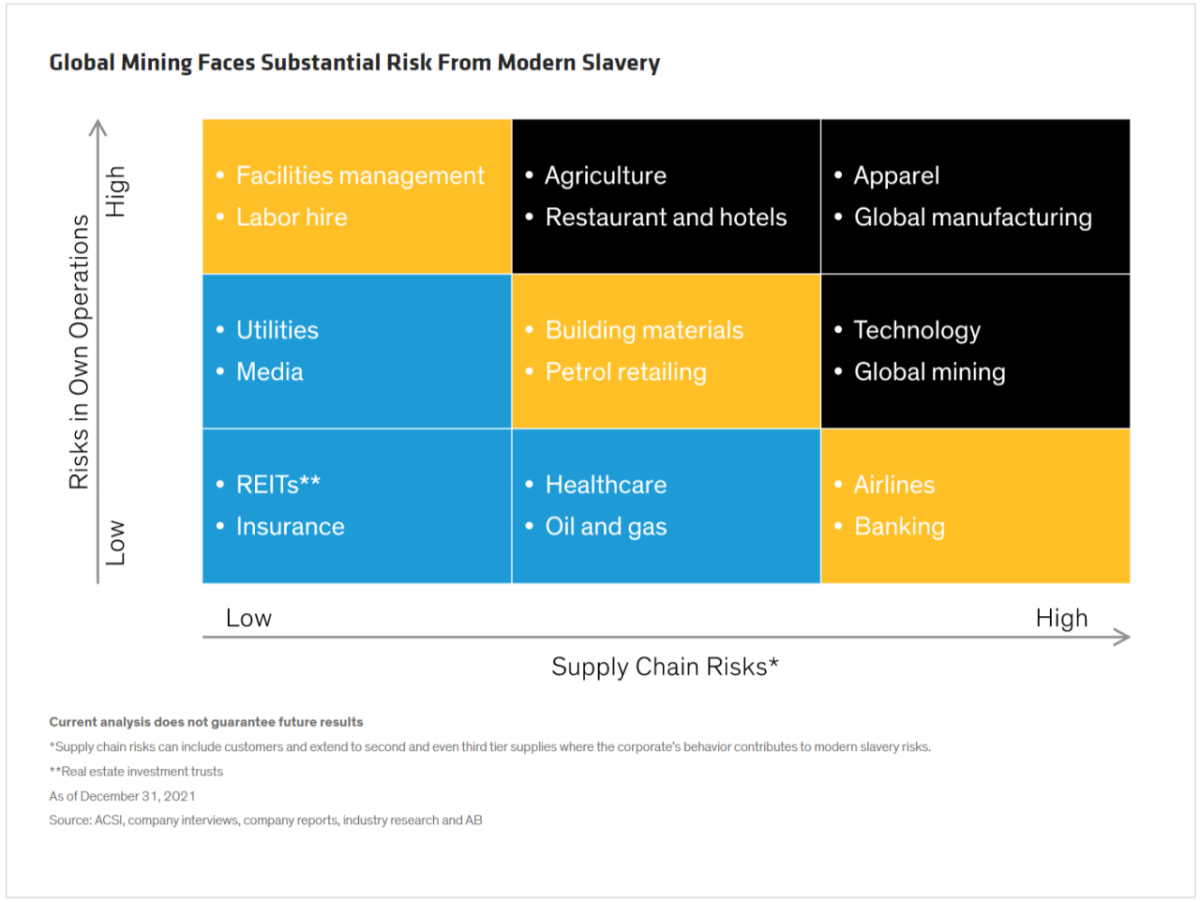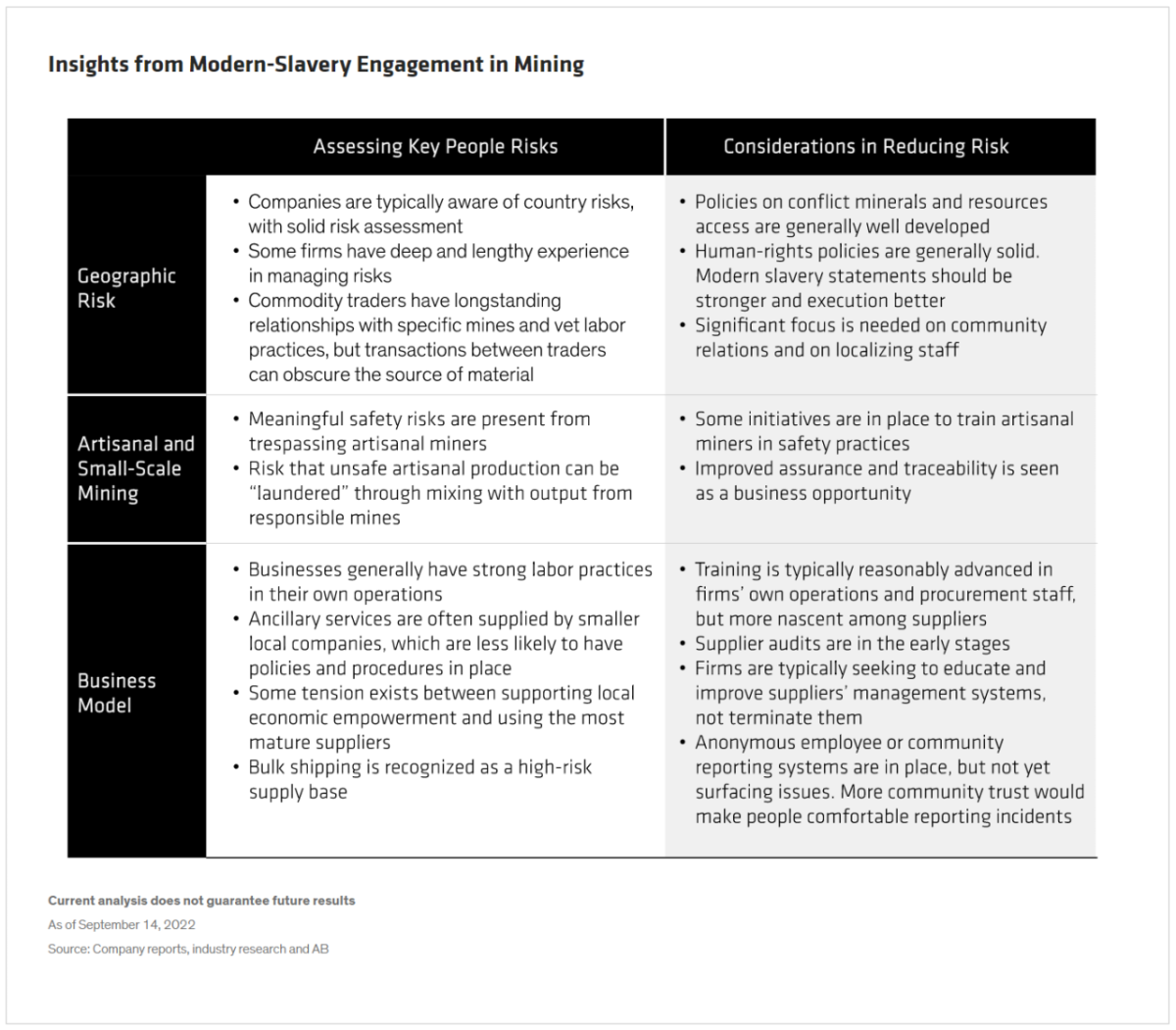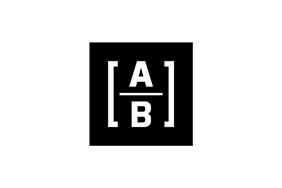AB: Modern Slavery in Mining Looms as a Key Risk to Investors
By Saskia Kort-Chick| Director of ESG Research and Engagement—Responsible Investing and Jeremy Taylor| Senior Research Analyst and Portfolio Manager—Value Equities
Published 03-16-23
Submitted by AllianceBernstein

Awareness that modern slavery is a social evil and investment risk continues to grow, putting investors in a pivotal position to identify and root out this risk across industries. Global mining is a particular challenge: risks to people in this industry are high and rising, and they’re not well-managed when compared with high-risk consumer-facing industries such as technology and apparel.
The mining industry sources its employees from particularly vulnerable populations, such as migrant workers and minorities. Many firms operate in geographies rife with conflict, corruption or weak judiciary systems. The work of mining itself is dangerous and the business models—which often rely on outsourcing and seasonal demand—can be high-risk, too.
It’s no surprise, then, that our research places the mining industry high among risks to people—both within its business operations and throughout its supply chains (Display). And in our view, the risks are rising.
Some of the rising risk stems from growing scrutiny from governments and intergovernmental organizations. The US has already implemented conflict minerals legislation, and the European Union (EU) implemented its Corporate Sustainability Reporting Directive on January 5, 2023. The new directive will require large EU and non-EU companies with a significant presence there to report on social factors including working conditions, equality, non-discrimination, diversity and inclusion, human rights, and the effects of the specific undertaking on people and human health.
In February 2022, the EU Commission presented a Proposal for Corporate Sustainability Due Diligence. Once legislated, it will cover companies’ human rights and environmental obligations. In September 2022, it launched a Proposal for Forced Labour Regulation. The proposal doesn’t single out the mining industry, but it encompasses companies that use forced labor. If the proposal becomes law, it will ban their products from being imported by and exported from the EU.
The United Nations (UN) Sustainable Development Goals aim to eradicate modern slavery by 2030, and in December 2022, the UN-backed Principles for Responsible Investment launched an initiative to engage with companies on social issues and human rights. The largest effort of its kind, it was supported by more than 220 asset managers representing US$30 trillion under management.
The first targets for the initiative? The mining, metals and renewables sectors. Other sources of growing risks are geopolitical in nature. The push to make wider use of renewable energy sources along with other technological changes—including advances in military equipment—is driving intense demand for some minerals. Competition could be magnified even further, with not only companies but also governments battling for relatively scarce resources.
As these pressures increase, so will the uncertainty for people working in the mining industry, particularly those in the most remote and least transparent stretches of supply chains. And the stakes are raised for investors, as they seek to identify and manage risk to people in investment portfolios. How can these efforts be made more effective?

In Mining, Geography Is a Major Risk Factor
As we see it, the key is to have a strong framework for assessing modern slavery risk across all companies in the relevant investment universe, not just those that are in investors’ portfolios. Using a combination of fundamental analysis and specialist third-party research, it’s possible to prioritize companies and industries according to their modern-slavery risk exposures.
Our own framework is based on four key risk factors—vulnerable populations, high-risk geographies, high-risk products and services, and high-risk business models. All of these facets apply to mining operations and supply chains.
Why is mining risk so high? It’s an economically important industry, particularly to emerging countries. Of the 40 nations that depend on non-fuel minerals for more than 25% of their exports, 75% are low- and middle-income economies.
Because the industry is woven so deeply into emerging countries, it’s a key source of people risk in many of those areas. For example, artisanal and small-scale mining (referred to as ASM), a relatively dangerous occupation often plagued with poor safety practices, occurs mainly in these countries. According to the International Labour Office, nearly 13 million people work in ASM, and an estimated 100 million depend on it for their livelihoods.
People risks in many areas with mining operations include exploitative conditions in remote locations, the relocation—sometimes forced—of indigenous people to gain access to minerals, and association with organized crime or armed conflict. These dangers are likely to intensify, because much of the future demand growth for minerals will fall on high-risk geographies.
Engagement Yields Understanding…and Insights
While the broader modern-slavery risk framework is a useful tool, true insight comes from understanding each firm’s exposure. While the risk factors are high across the industry, they vary from company to company, as will awareness of risks and efforts to manage them.
Understanding individual modern-slavery risk exposures requires not only strong research skills and collaboration between fundamental analysts and in-house environmental, social and governance (ESG) experts, but also a clear sense of risk-management best practices.
A willingness to engage directly with firms to identify and address the issues is also key. Engagement for both insight and action has the potential to reduce risks not only for employees in businesses’ mining operations and supply chains, but also for companies and investors. It’s a golden opportunity to raise companies’ awareness of the modern-slavery risks they face and help them develop effective ways to manage them.
Our own engagement on this topic shows that, while risk awareness among mining companies is reasonably high or increasing, more action can be taken to manage the risks. For example, the companies we’ve engaged with generally have solid policies in place on human rights and modern slavery, but the quality of execution varies considerably. One key takeaway: training on this issue is quite advanced within firms’ own operations and procurement staffs but is still in the earlier stages with suppliers (Display).
In our view, companies have a long way to go when it comes to introducing modern-slavery risk audits into their supply chains. They’ve established anonymous employee or community reporting systems, but these mechanisms haven’t yet brought the issues to light, which raises important questions about their effectiveness.

How Investors Can Manage Their Risks—and Make a Difference
Based on our assessment, the global mining industry is high risk in nature, and it lags other industries, such as technology and apparel, in risk awareness and reduction efforts.
Part of the challenge stems from these industries’ different structures. Technology and apparel are highly sensitive to consumer opinion, and modern-slavery awareness is rising among all-important consumers. Because mining companies do business mainly with other companies, they’re to some degree more insulated from consumer opinion than their retail peers.
But that insularity won’t last.
The industry’s corporate customers are becoming more aware of modern-slavery risk and applying more stringent requirements to the miners that supply them. Governments are stepping up their scrutiny of mining companies and supply chains. In the short term, this poses a challenge to mining operations and revenues, and it puts more pressure on investors to diagnose which businesses are responding effectively to the increased attention.
With a thoughtful framework, sound research and company engagement, investors can identify and manage these risks in their portfolios. At the same, they can help mining companies improve their people risk practices—and ultimately make life safer for many of the industry’s millions of workers.
The views expressed herein do not constitute research, investment advice or trade recommendations and do not necessarily represent the views of all AB portfolio-management teams. Views are subject to change over time.
Learn more about AB’s approach to responsibility here

AllianceBernstein
AllianceBernstein
AllianceBernstein (AB) is a leading global investment management firm that offers diversified investment services to institutional investors, individuals, and private wealth clients in major world markets.
To be effective stewards of our clients’ assets, we strive to invest responsibly—assessing, engaging on and integrating material issues, including environmental, social and governance (ESG) considerations into most of our actively managed strategies (approximately 79% of AB’s actively managed assets under management as of December 31, 2024).
Our purpose—to pursue insight that unlocks opportunity—describes the ethos of our firm. Because we are an active investment manager, differentiated insights drive our ability to design innovative investment solutions and help our clients achieve their investment goals. We became a signatory to the Principles for Responsible Investment (PRI) in 2011. This began our journey to formalize our approach to identifying responsible ways to unlock opportunities for our clients through integrating material ESG factors throughout most of our actively managed equity and fixed-income client accounts, funds and strategies. Material ESG factors are important elements in forming insights and in presenting potential risks and opportunities that can affect the performance of the companies and issuers that we invest in and the portfolios that we build. AB also engages issuers when it believes the engagement is in the best financial interest of its clients.
Our values illustrate the behaviors and actions that create our strong culture and enable us to meet our clients' needs. Each value inspires us to be better:
- Invest in One Another: At AB, there’s no “one size fits all” and no mold to break. We celebrate idiosyncrasy and make sure everyone’s voice is heard. We seek and include talented people with diverse skills, abilities and backgrounds, who expand our thinking. A mosaic of perspectives makes us stronger, helping us to nurture enduring relationships and build actionable solutions.
- Strive for Distinctive Knowledge: Intellectual curiosity is in our DNA. We embrace challenging problems and ask tough questions. We don’t settle for easy answers when we seek to understand the world around us—and that’s what makes us better investors and partners to our colleagues and clients. We are independent thinkers who go where the research and data take us. And knowing more isn’t the end of the journey, it’s the start of a deeper conversation.
- Speak with Courage and Conviction: Collegial debate yields conviction, so we challenge one another to think differently. Working together enables us to see all sides of an issue. We stand firmly behind our ideas, and we recognize that the world is dynamic. To keep pace with an ever changing world and industry, we constantly reassess our views and share them with intellectual honesty. Above all, we strive to seek and speak truth to our colleagues, clients and others as a trusted voice of reason.
- Act with Integrity—Always: Although our firm is comprised of multiple businesses, disciplines and individuals, we’re united by our commitment to be strong stewards for our people and our clients. Our fiduciary duty and an ethical mind-set are fundamental to the decisions we make.
As of December 31, 2024, AB had $792B in assets under management, $555B of which were ESG-integrated. Additional information about AB may be found on our website, www.alliancebernstein.com.
Learn more about AB’s approach to responsibility here.
More from AllianceBernstein

